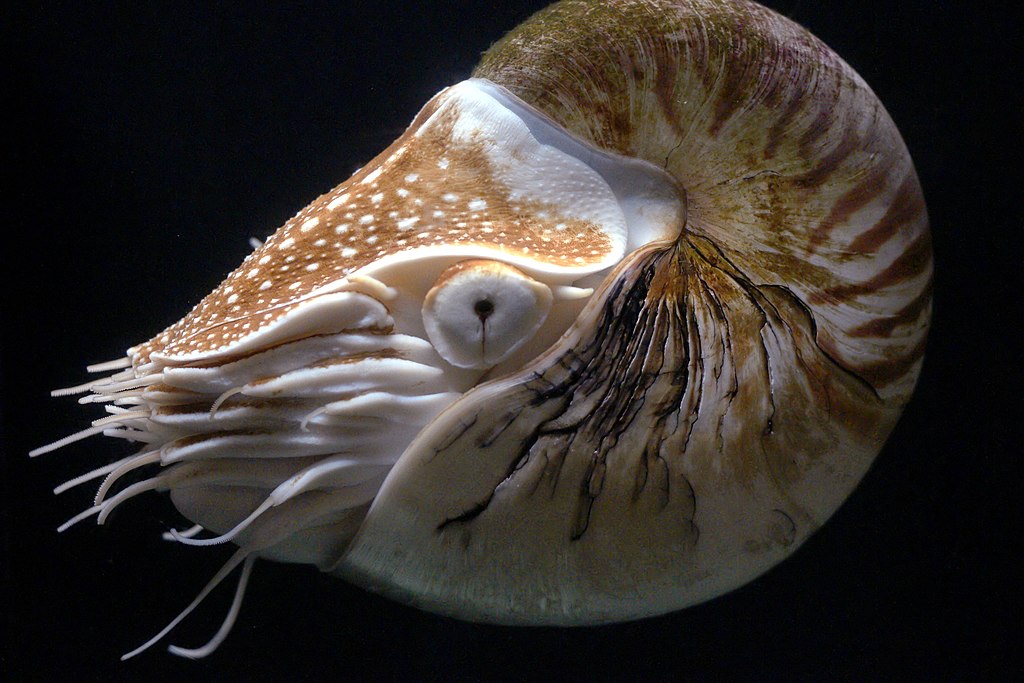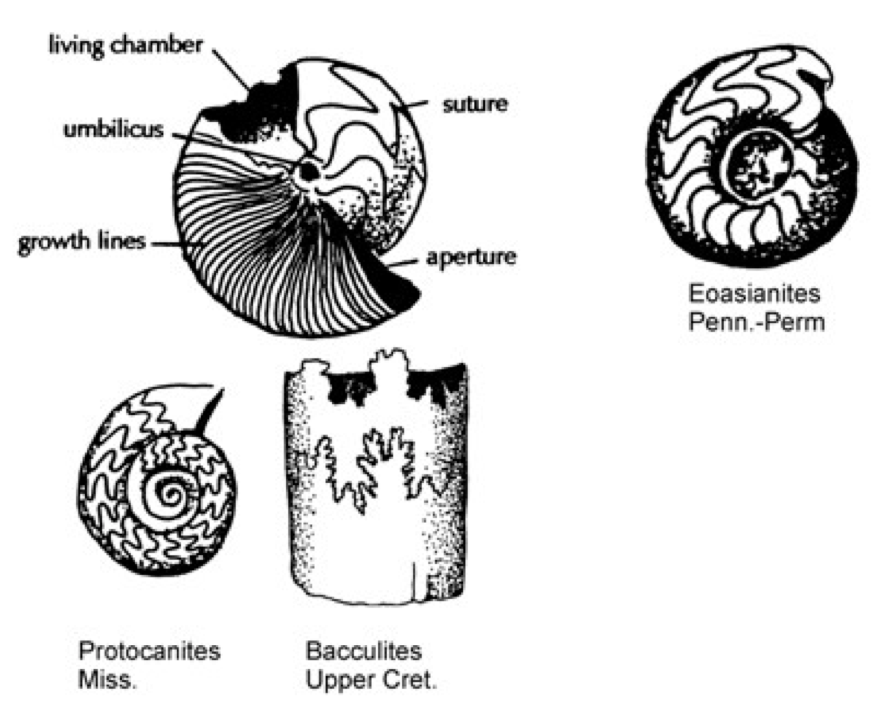Phylum Mollusca, Class Cephalopoda
Phylum Mollusca includes several types of animals with very different life habits and functions in an ecosystem. In Lab 7 we introduced two of the three major classes of Phylum Mollusca: Bivalvia and Gastropoda. We will now introduce Class Cephalopoda.
Class Cephalopoda includes squid, octopi, nautiloids and the extinct ammonoids. Cephalopods are strong swimmers in contrast to the slow-moving gastropods and bivalves. They have keen eyesight and are alert, aggressive predators that compete with vertebrate predators in the sea. They attained the largest physical size of all the invertebrates (squid can grow to over 10 metres in length, and ammonoids likely reached more than 2 metres diameter). All cephalopods have a circle of fleshy tentacles or limb-like processes with hooklets and/or suckers around the mouth.
The two subclasses of cephalopods that we will focus on in this course include animals that were enclosed in a shell: Subclass Nautiloidea (the nautiloids) which includes the modern living nautilus (Figure 8.8), and Subclass Ammonoidea (the ammonoids) which is now extinct.

The shells of these subclasses are always chambered and the chambers are separated by partitions which attached to the shell along a junction line called the suture (Figure 8.9). The chambers represent successive portions of the shell which were vacated as the animal grew. The animal occupies only the last chamber and the rest are filled with gas. However, the animal retains a connection to the abandoned chambers by a slender tube that runs back through the septa, allowing it to manage its buoyancy and stability in the water.

Nautiloids (Lower Devonian to Present, Peak in Mesozoic)
The earliest of these outer-shelled cephalopods were straight or gently curved, and chambered. The largest of these reached up to 10 m in length. Over time the shells became coiled and nautiloids and ammonoids emerged. The nautiloids have planispiral coiled shells with chamber divisions that meet the outer wall in a simple smooth curve. They emerged during the Cambrian and reached their peak in the Mesozoic, before largely dying out in the Cretaceous extinction. The only surviving nautiloid is Nautilus (Figure 8.8).
A. Sample 37: Modern Coiled Nautiloid
This sample can be picked up, but please treat it with care.
The nautiloids were the first to arise in the Devonian, and have survived to the modern day. This is a cross-section of a modern nautiloid.
Questions a & b
a. Why did the animal keep adding chambers to its shell (that is, what was the biological purpose of the chambers)?
b. Notice the holes that pass from the outer chamber into the inner chambers. What was this for?
B. Sample 39: Uncoiled Nautiloid
This sample can be picked up, but please treat it with care.
This is an example of an uncoiled nautiloid. Most of the specimens we will see are coiled, but both within the nautiloids and ammonoids there were species whose shells were straight.
Question c
Ammonoids (Devonian to Cretaceous, Peak Jurassic to Cretaceous)
The ammonoids include three orders that represent an increasing complexity of shell form: the goniatites, the ceratites and the ammonites (notice the “ite” ending instead of the “oid” ending). These are distinguished from each other by increasing complexity of the suturing displayed, which is the way in which the chamber walls met the outer shell. The suturing pattern becomes more complex from the nautiloids to the goniatites, the ceratites and the true ammonites (Figure 8.10).

The nektonic life habit of nautiloids and ammonoids make them widely distributed. While all goniatites were relatively small (less than 15 cm) and had planispiral coiling, shells forms began to vary in the ceratites where some planispiral coils had a hole in the centre. The majority of ammonites had planispiral coiling, but there were also many variations including paper-clip like shapes, conispiral, and completely irregular coils. Ammonites also attained monstrous sizes, with some fossil shells measuring 2 m or more in diameter. Their hard, easily preserved calcite shells, their easy identification based on suture patterns and the short time range of individual species all combine to make ammonoids excellent guide or index fossils for the Devonian to the end of the Cretaceous.
C. Sample 121-34: Ammonoid
These samples can be picked up, but please treat them with care.
The inner chambers (closer to the center of the coil) of these shells have been permineralized and appear white. The whole outer shell has been polished away. The chamber walls are still visible as thing grey lines.
Question d
D. Sample 121-53: Ammonite
This sample can be picked up, but please treat it with care.
Suture marks are clearly visible on the exterior surface of these samples. Ease of identification is one reason ammonite fossils are used as index (or guide) fossils in biostratigraphy.
Questions e & f
e. Look at the end of the segments and the shape of the chamber walls. What structural purpose does this complex suture shape serve?
f. Compare Sample 121-53 with samples FFC-24 and 6B below. Generalize from your observations and draw an example ammonite that you can use as a study guide. Label the key features of your drawing.
E. Sample FFC-24: Ammonite
This sample can be picked up, but please treat it with care.
F. Sample 6B: Ammonites
These samples can be picked up, but please treat them with care.
G. NB3: Baculites Ammonite
This sample can be picked up, but please treat it with care.
This sample is an example of an ammonite with a straight shell. The sample is a short fragment of an elongated shell that tapers at one end.
Question g
